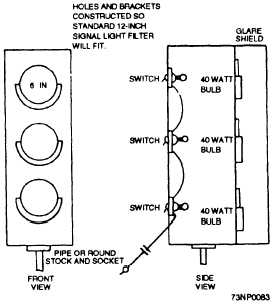station by displaying the designated flag over the
colored debarkation station flag (see fig. 12-6). For
example, to call the LCM 8 required at (port)
debarkation station BLUE 6, the signal bridge hoists
the 8 flag over the BLUE flag at the port yardarm.
When boats are alongside the designated station, the
flag signal is hauled down.
Night
A light box (fig. 12-7) is mounted on a swivel
base at the signal station on each side of the ship for
aiming at a particular assembly area. The box is
fitted with three holes on a vertical line and is
Day
shielded at the front so the lights are visible in one
assembly area only. The holes will be of such size
to permit interchange of the standard colored light
filters for a 12-inch searchlight.
The top color in the light box indicates starboard
or port side; the middle color indicates type of boat or
craft desired; and the bottom color designates the
debarkation station (see fig. 12-6).
Each debarkation station suspends a small,
single-cell flashlight colored the same color as the
debarkation station marker. All lights are in the same
location as the station marker painted on the hull.
These small lights serve only to identify the stations
as the boat or craft comes close alongside.
Day and Night
Landing craft are called alongside by signal on
orders from the debarkation officer. Loudspeaker
equipment may be used as a supplementary means of
Figure 12-7.—Debarkation light box.
communication. Radio to the boat group commander
(BGC) or his or her assistant may be used as a backup.
PROCEDURES FOR CALLING
BOATS AND CRAFT INTO WELL
DECKS/TANK DECKS
Signals are used to call boats and landing craft
from on-call circles into the well decks, to the tank of
an LST for stern gate marriages, or to embark troops
or cargo.
Signals are similar to those used in calling boats
or craft to debarkation stations. To call boats or craft
into well decks, the signal bridge hoists the signal for
a type of boat or craft (see fig. 12-6). To call an LCM
8, for example, the signal bridge hoists (on either
yardarm with the exception of LHAs) flag 8 over flag
WHISKEY, which would tell the boats in the on-call
circle that a single LCM 8 is to enter the well deck. To
bring two LCM 8s married into the well, the signal is
flag 8 over flag 8 over flag WHISKEY. This indicates
that two LCM 8s are to marry up in the on-call circle
and enter the well deck Once the boats cross the sill,
the well deck control officer positions them at any
desired station. For calling boats or craft into the well
deck of an LHA, the signal bridge hoists flag signals
on the port or starboard yardarm to indicate which side
of the split well deck the boat or craft is to make.
To call LCUs or LVTs to the tank deck, the signal
bridge hoists the appropriate flag over the WHISKEY
flag from either yardarm.
Night
At night, the light box and the same middle light
color signals are used for calling individual boats and
craft alongside. The top light for calling boats to the
well deck is white instead of red or green. The bottom
light is left blank when single boats are called. To have
boats marry up, the bottom light is white. For LHAs,
a steady top light indicates a boat or craft is to make
the starboard side of the split well deck A flashing top
light indicates the port side of the split well.
CONTROL ORGANIZATION
LEARNING OBJECTIVES: Explain the duties
of the control organization personnel, including
the duties of the central control officer (CCO),
a BGC, and the BWC.
12-8


